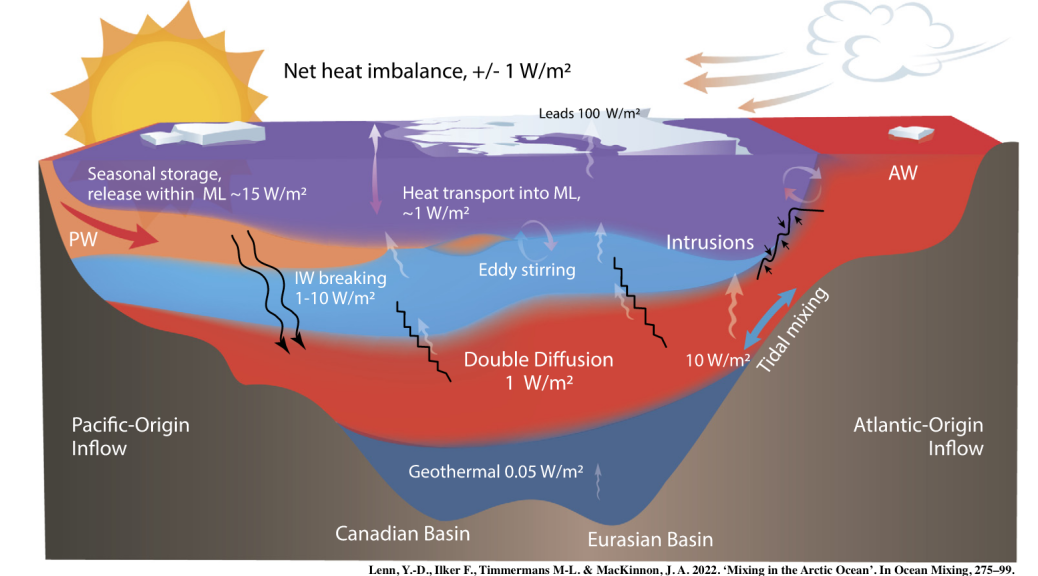
Lead supervisor: Adrien Lefauve, DAMTP
Co-supervisor: Ali Mashayek, Earth Sciences
Brief summary:
This project will use laboratory experiments and modelling to quantify the changing patterns of turbulent mixing between water masses in a rapidly warming Arctic Ocean, which are crucial in shaping the future climate of the Northern Hemisphere.
Importance of the area of research concerned:
The Arctic region experiences the most rapid environmental changes on Earth, warming twice as fast as the global average. This ‘Artic Amplification’ feedback loop is a hot topic since the reduction in the atmospheric meridional temperature gradient impacts mid-latitude (including UK) climate, weather and extremes.
The Artic Ocean is key in cooling the regional and global climate due to the high albeldo of sea-ice. The dramatic decline in sea-ice will increase air-sea heat transfer and wind kinetic energy transfer to the ocean, which will likely spin up the circulation. This is expected to inject more energy into ocean turbulence and mixing, with the risk of slowly upwelling deeper, warmer waters from the Atlantic Ocean to the surface, accelerating sea-ice melting further.
Evaluating the likelihood and time scale of such catastrophic scenarios and considering mitigation measures require a faithful representation of turbulent mixing processes in regional and global climate models, which is currently missing. Changing mixing patterns in the Arctic will not only affect the climate, but also nutrient transport, primary productivity, the food web, and carbon sequestration.
Project summary :
A unique and influential feature of the Arctic Ocean is that its stable density stratification consists of fresher waters overly saltier waters with a particularly sharp halocline. The stacking of cold, fresh Arctic waters and warm, saltier waters from the Atlantic causes a fascinating double-diffusive density ‘staircase’ structure at the halocline, which plays a key role in preventing Atlantic heat from mixing up to the surface and melting sea ice.
Will this insulating staircase remain in a more energetic ocean? Or will faster currents, and hence stronger shear and turbulence, from the surface (swell) down to the seafloor (lee waves), disrupt it and increase Atlantic heat flux? Further small-scale processes add complexity and unpredictability, such as stronger baroclinic eddies, meltwater discharge and brine rejection. This project will tackle and model these exciting new physics.
What will the student do?:
The long-standing difficulty of acquiring observational data and of resolving very-fine-scale fluid motion in direct numerical simulations make controlled laboratory experiments particularly attractive to study ocean turbulence. This project aims to fill the gap in our understanding by bringing together observations, numerics, and experiments, with new experiments being a focal point.
This project will exploit the unique facilities of the G. K. Batchelor Laboratory in DAMTP, which has over 800m2 of dedicated floor space and a rich history in developing insightful experimental models to tackle influential geophysical fluid dynamics. Several state-of-the-art measurement techniques may be used to acquire flow data at high spatial and temporal resolution, including particle image velocimetry, laser induced fluorescence, and synthetic schlieren.
Mathematical models will then be constructed to interpret these data and yield general findings applicable to the large-scale problem of Arctic turbulent mixing. Finally, simplified representations of these mixing processes may be developed and implemented in climate models, from which future scenarios can be computed.
References - references should provide further reading about the project:
Timmermans, M-L. & Marshall, J. 2020. ‘Understanding Arctic Ocean Circulation: A Review of Ocean Dynamics in a Changing Climate’. Journal of Geophysical Research: Oceans 125, no. 4 https://doi.org/10.1029/2018JC014378.
Lenn, Y.-D., Ilker F., Timmermans M-L. & MacKinnon, J. A. 2022. ‘Mixing in the Arctic Ocean’. In Ocean Mixing, 275–99. Elsevier https://doi.org/10.1016/B978-0-12-821512-8.00018-9.
Rippeth, T. & Fine, E. 2022. ‘Turbulent Mixing in a Changing Arctic Ocean’. Oceanography, https://doi.org/10.5670/oceanog.2022.103.
Applying
You can find out about applying for this project on the Department of Applied Mathematics and Theoretical Physics (DAMTP) page.